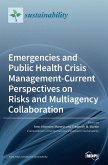Kathleen G. V. Melville (Loui Tulane University School of Medicine
Risk Communication in Public Health Emergencies
Kathleen G. V. Melville (Loui Tulane University School of Medicine
Risk Communication in Public Health Emergencies
- Broschiertes Buch
- Merkliste
- Auf die Merkliste
- Bewerten Bewerten
- Teilen
- Produkt teilen
- Produkterinnerung
- Produkterinnerung
Clearly explains how public health officials plan, deliver and evaluate crisis and emergency risk communication before, during, and after health emergencies. COVID-19, Zika, Ebola, and Mpox are analysed using the Crisis and Emergency Risk Communication framework to effectively communicate accurate and actionable health information to the public.
Andere Kunden interessierten sich auch für
![Emergencies and Public Health Crisis Management- Current Perspectives on Risks and Multiagency Collaboration Emergencies and Public Health Crisis Management- Current Perspectives on Risks and Multiagency Collaboration]() Emergencies and Public Health Crisis Management- Current Perspectives on Risks and Multiagency Collaboration59,99 €
Emergencies and Public Health Crisis Management- Current Perspectives on Risks and Multiagency Collaboration59,99 €![One Health One Health]() One Health94,99 €
One Health94,99 €![Health in Humanitarian Emergencies Health in Humanitarian Emergencies]() Health in Humanitarian Emergencies132,99 €
Health in Humanitarian Emergencies132,99 €![Emergencies in Public Law Emergencies in Public Law]() Karin LoevyEmergencies in Public Law80,99 €
Karin LoevyEmergencies in Public Law80,99 €![Joint Models for Longitudinal and Time-to-Event Data Joint Models for Longitudinal and Time-to-Event Data]() Dimitris RizopoulosJoint Models for Longitudinal and Time-to-Event Data109,99 €
Dimitris RizopoulosJoint Models for Longitudinal and Time-to-Event Data109,99 €![Disability Justice in Public Health Emergencies Disability Justice in Public Health Emergencies]() Disability Justice in Public Health Emergencies55,99 €
Disability Justice in Public Health Emergencies55,99 €![Emergencies and Politics Emergencies and Politics]() Professor Tom SorellEmergencies and Politics109,99 €
Professor Tom SorellEmergencies and Politics109,99 €-
-
-
Clearly explains how public health officials plan, deliver and evaluate crisis and emergency risk communication before, during, and after health emergencies. COVID-19, Zika, Ebola, and Mpox are analysed using the Crisis and Emergency Risk Communication framework to effectively communicate accurate and actionable health information to the public.
Produktdetails
- Produktdetails
- Verlag: Cambridge University Press
- Seitenzahl: 342
- Erscheinungstermin: 13. Mai 2025
- Englisch
- Abmessung: 234mm x 156mm x 18mm
- Gewicht: 510g
- ISBN-13: 9781009449038
- ISBN-10: 1009449036
- Artikelnr.: 72182515
- Herstellerkennzeichnung
- Libri GmbH
- Europaallee 1
- 36244 Bad Hersfeld
- gpsr@libri.de
- Verlag: Cambridge University Press
- Seitenzahl: 342
- Erscheinungstermin: 13. Mai 2025
- Englisch
- Abmessung: 234mm x 156mm x 18mm
- Gewicht: 510g
- ISBN-13: 9781009449038
- ISBN-10: 1009449036
- Artikelnr.: 72182515
- Herstellerkennzeichnung
- Libri GmbH
- Europaallee 1
- 36244 Bad Hersfeld
- gpsr@libri.de
Kathleen G. V. Melville, Ph.D, is an expert in emergency risk communications with 17 years' experience working in state, local, and federal public health agencies. During the COVID-19 pandemic she worked in the Centers for Disease Control and Prevention's Joint Information Center and continues to work for the agency as a health communications specialist. She also teaches disaster communication at Tulane University.
1. Why you need to care about emergency risk communication; Part I.
Precrisis Planning; 2. Precrisis planning is necessary for public
information and emergency communications: Leveraging what you've got; 3.
Identifying who needs to know what and when: It's not a surprise what your
audiences need to know; 4. Addressing the information needs of the public
and medical community during a public health emergency; 5. How to get the
message out: Understanding all of your communication channels and when to
use them; Part II. Communicating during a Health Emergency; 6. Initial
messages during a health emergency: addressing uncertainty and creating
trust with the public; 7 Maintenance messages during a health emergency:
How to protect the public's health and debunking misinformation; 8.
Communicating during long public health emergencies: Creating health
communication campaigns; Part III. Communicating and Planning after a
Health Emergency; 9. Pivoting from crisis management to recovery:
Communicating the end of a health emergency; 10. Evaluating emergency risk
communication and engaging in public education for the next emergency; Part
IV. Crisis Leadership; 11. Effective communication during a health
emergency: The role of the spokesperson and working with the media; 12.
Crisis leadership: Staying steady on unsteady ground; Index.
Precrisis Planning; 2. Precrisis planning is necessary for public
information and emergency communications: Leveraging what you've got; 3.
Identifying who needs to know what and when: It's not a surprise what your
audiences need to know; 4. Addressing the information needs of the public
and medical community during a public health emergency; 5. How to get the
message out: Understanding all of your communication channels and when to
use them; Part II. Communicating during a Health Emergency; 6. Initial
messages during a health emergency: addressing uncertainty and creating
trust with the public; 7 Maintenance messages during a health emergency:
How to protect the public's health and debunking misinformation; 8.
Communicating during long public health emergencies: Creating health
communication campaigns; Part III. Communicating and Planning after a
Health Emergency; 9. Pivoting from crisis management to recovery:
Communicating the end of a health emergency; 10. Evaluating emergency risk
communication and engaging in public education for the next emergency; Part
IV. Crisis Leadership; 11. Effective communication during a health
emergency: The role of the spokesperson and working with the media; 12.
Crisis leadership: Staying steady on unsteady ground; Index.
1. Why you need to care about emergency risk communication; Part I.
Precrisis Planning; 2. Precrisis planning is necessary for public
information and emergency communications: Leveraging what you've got; 3.
Identifying who needs to know what and when: It's not a surprise what your
audiences need to know; 4. Addressing the information needs of the public
and medical community during a public health emergency; 5. How to get the
message out: Understanding all of your communication channels and when to
use them; Part II. Communicating during a Health Emergency; 6. Initial
messages during a health emergency: addressing uncertainty and creating
trust with the public; 7 Maintenance messages during a health emergency:
How to protect the public's health and debunking misinformation; 8.
Communicating during long public health emergencies: Creating health
communication campaigns; Part III. Communicating and Planning after a
Health Emergency; 9. Pivoting from crisis management to recovery:
Communicating the end of a health emergency; 10. Evaluating emergency risk
communication and engaging in public education for the next emergency; Part
IV. Crisis Leadership; 11. Effective communication during a health
emergency: The role of the spokesperson and working with the media; 12.
Crisis leadership: Staying steady on unsteady ground; Index.
Precrisis Planning; 2. Precrisis planning is necessary for public
information and emergency communications: Leveraging what you've got; 3.
Identifying who needs to know what and when: It's not a surprise what your
audiences need to know; 4. Addressing the information needs of the public
and medical community during a public health emergency; 5. How to get the
message out: Understanding all of your communication channels and when to
use them; Part II. Communicating during a Health Emergency; 6. Initial
messages during a health emergency: addressing uncertainty and creating
trust with the public; 7 Maintenance messages during a health emergency:
How to protect the public's health and debunking misinformation; 8.
Communicating during long public health emergencies: Creating health
communication campaigns; Part III. Communicating and Planning after a
Health Emergency; 9. Pivoting from crisis management to recovery:
Communicating the end of a health emergency; 10. Evaluating emergency risk
communication and engaging in public education for the next emergency; Part
IV. Crisis Leadership; 11. Effective communication during a health
emergency: The role of the spokesperson and working with the media; 12.
Crisis leadership: Staying steady on unsteady ground; Index.








